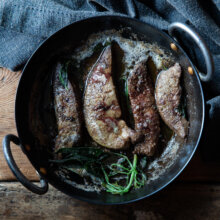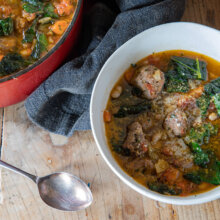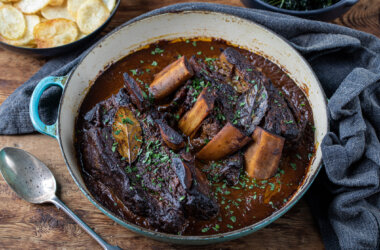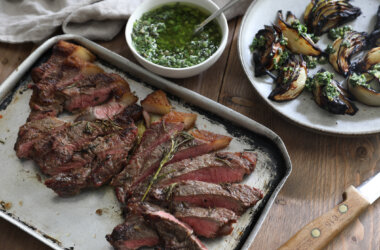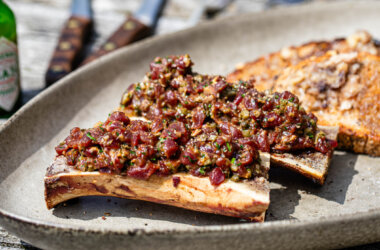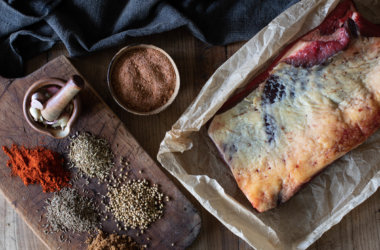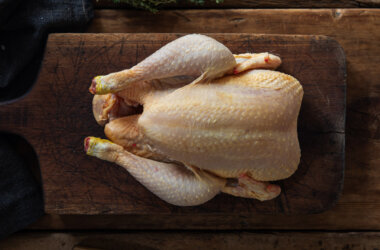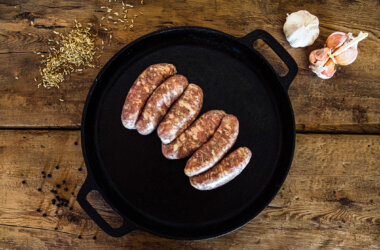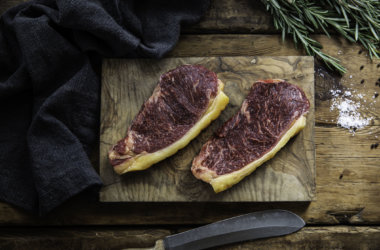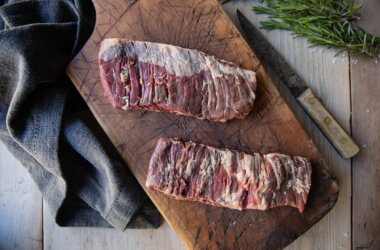This gloriously flavoursome mutton mince from Swaledale Butchers takes on an intriguing guise as the filling for a cabbage leaf, and is totally delicious. These parcels nestled in a swamp of sweet soft onions and stock make for a rich and comforting supper.
I believe that this type of dish might have spent a few years in the wilderness in this country — I presume that the French have been cooking chou farcie with fair regularity. Equally in Poland, it is never far away from a dinner table, but while we were all waiting to see what Jamie Oliver was going to cook next, we forgot about the humble stuffed cabbage.
Thankfully, it only takes a brief scroll through Instagram, and the pages of some of our favourite restaurants, to see that they (the stuffed cabbages) are making a triumphant return. Terrific news, I would say. As this recipe below would testify, they are a truly delicious thing to eat.

Serves 5-6
Ingredients
Filling
Gravy
Swede
Method
To stuff the cabbage leaves:
- You first need to make the stuffing. So, take a pan and add the duck fat, shallots and the thyme. Season with salt and cook on a low heat until the shallots are well softened but haven’t coloured too much.
- Add the whiskey and allow to simmer for 2 minutes. Remove from the heat and set aside to cool slightly.
- Tip the mutton mince into a mixing bowl and add the cooked shallots, the oats, the ground cloves, a gentle grate of nutmeg, and a few twists of black pepper. Season with salt and give a good mix with your hands to combine well.
- Check the seasoning by taking a little of the mix and frying in a pan. Adjust the seasoning as necessary.
In the meantime, begin the gravy:
- In a large pan, add the duck fat, onions, bay leaves and a pinch of salt. Cook over a medium heat with a lid on, stirring regularly, for about 25 minutes. The onions should be soft and sweet but still pale in colour.
- Heat up the chicken stock in a separate pan.
- Add the flour to the onions and stir. Let the flour cook with the onions for a couple of minutes, stirring regularly.
- Then add a ladle of the hot stock and continue to stir — it should thicken quite quickly.
- Then add the remaining stock, stir and bring up to a simmer. Cook like this for 20 minutes.
- Check seasoning and adjust as necessary.
Returning to the cabbage:
- Peel the leaves off the cabbage, being careful not to break them, its much easier if they are whole. You will need about 10 nice, undamaged leaves.
- Bring a pot of salted water to the boil. Have a bowl with iced water to hand.
- Blanch the leaves of the cabbage, in batches, for 2 minutes and then plunge into the icy water. This will help to prevent them from overcooking and going mushy — which would not be desirable for stuffing.
- Once all the leaves are blanched, drain them well, ready to begin stuffing.
- Lay a leaf out flat on a clean surface. If the bottom of the stalk is particularly tough or thick, then take a sharp knife and cut it out, cutting as close to the stalk as possible and not cutting all the way to the top.
- Use a rolling pin to flatten the leaf and then take a golf ball sized piece of the mutton mince and roll it into a cylinder. Place it onto the cabbage leaf, close to the bottom. Roll upwards, tucking in the sides before you get to the very top and fasten the parcel with a toothpick. You should have a sealed, cylindrical parcel.
- Repeat this process until the mutton mince has all been used.
- Preheat the oven to 170°C.
- Tip the onion gravy into an ovenproof dish and then nestle in the cabbage leaves. Leaving a little space in between each one. Place the dish in the oven and cook for 18-20 minutes.
To cook the swede:
- Add the diced swede, butter, stock, several twists of black pepper and a good pinch of salt to a pot and set it over a medium heat.
- Bring the liquid to a simmer and then cover with a lid. Cook like this for 30 minutes, returning to the pot to stir fairly regularly. Add a little more liquid to the pot if it is looking at all dry.
- After 30 minutes the swede should be cooked, at which point, give it a gentle crush with anything you can lay your hands on – the back of a fork, a masher, the end of a rolling pin or even a wooden spoon.
- Check the seasoning and adjust if necessary, it usually likes quite a bit of black pepper.
- Serve the cabbage rolls on top of the swede and spoon over a good amount of the onion gravy —don’t forget to remove the toothpicks.

